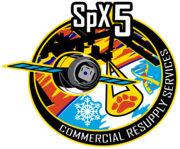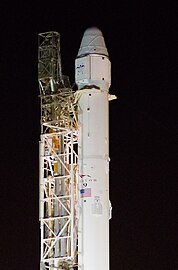 CRS-5 Dragon on approach to the ISS CRS-5 Dragon on approach to the ISS | |
| Names | SpX-5 |
|---|---|
| Mission type | ISS resupply |
| Operator | SpaceX |
| COSPAR ID | 2015-001A |
| SATCAT no. | 40370 |
| Mission duration | 31 days, 14 hours, 56 minutes |
| Spacecraft properties | |
| Spacecraft | Dragon 1 C107 |
| Spacecraft type | Dragon 1 |
| Manufacturer | SpaceX |
| Launch mass | 6,000 kg (13,000 lb) |
| Start of mission | |
| Launch date | 10 January 2015, 09:47:10 UTC |
| Rocket | Falcon 9 v1.1 (B1012) |
| Launch site | Cape Canaveral, SLC-40 |
| End of mission | |
| Disposal | Recovered |
| Landing date | 11 February 2015, 00:44 UTC |
| Landing site | Atlantic Ocean |
| Orbital parameters | |
| Reference system | Geocentric orbit |
| Regime | Low Earth orbit |
| Inclination | 51.65° |
| Berthing at ISS | |
| Berthing port | Harmony nadir |
| RMS capture | 12 January 2015, 10:54 UTC |
| Berthing date | 12 January 2015, 13:54 UTC |
| Unberthing date | 10 February 2015, 17:11 UTC |
| RMS release | 10 February 2015, 19:10 UTC |
| Time berthed | 29 days, 3 hours, 17 minutes |
| Cargo | |
| Mass | 2,317 kg (5,108 lb) |
| Pressurised | 1,823 kg (4,019 lb) |
| Unpressurised | 494 kg (1,089 lb) |
 NASA SpX-5 mission patch Commercial Resupply Services← Orbital-3SpaceX CRS-6 → Cargo Dragon← SpaceX CRS-4SpaceX CRS-6 → | |
SpaceX CRS-5, also known as SpX-5, was a Commercial Resupply Service mission to the International Space Station (ISS), conducted by SpaceX for NASA, and was launched on 10 January 2015 and ended on 11 February 2015. It was the seventh flight for SpaceX's uncrewed Dragon cargo spacecraft and the fifth SpaceX operational mission contracted to NASA under an ISS resupply services contract.
Launch history

By July 2014, the launch was scheduled by NASA for December 2014, with docking to the station projected to occur two days after launch. Originally scheduled for a 16 December 2014 launch, the mission was changed to 19 December 2014, in order to give SpaceX more preparation time for a successful launch. The launch was postponed again to 6 January 2015, in order to allow more tests before committing to a firm launch date.
On 6 January 2015, the launch attempt was placed on hold at 1 minute 21 seconds prior to scheduled lift-off after a member of the launch team noticed actuator drift on one of two thrust vector control systems of the Falcon 9 second stage engine. As this launch had an instantaneous launch window, meaning no delays are possible in the launch sequence, the flight was postponed to 9 January 2015. On 7 January 2015, the flight was rescheduled for 10 January 2015.
The Falcon 9 launch vehicle carrying the CRS-5 Dragon spacecraft successfully launched on 10 January 2015 at 09:47:10 UTC. Dragon reached the station on 12 January 2015. It was grappled by the Mobile Servicing System (Canadarm2) at 10:54 UTC and berthed to the Harmony module at 13:56 UTC.
Primary payload
The Dragon spacecraft for CRS-5 carried 2,317 kg (5,108 lb) of cargo to the ISS. Included in this was 490 kg (1,080 lb) of provisions and equipment for the crew, 717 kg (1,581 lb) of station hardware, 577 kg (1,272 lb) of science equipment and experiments, and the 494 kg (1,089 lb) Cloud Aerosol Transport System (CATS).
CATS is a LIDAR remote sensing instrument designed to measure the location, composition and distribution of pollution, dust, smoke, aerosols and other particulates in the atmosphere. CATS is to be installed on the Kibō module external facility and is expected to run for at least six months, and up to three years.
Upon completion of its stay, Dragon was loaded with 1,332 kg (2,937 lb) of outgoing cargo, returning it back to Earth.
Post-launch flight test
Main article: SpaceX reusable launch system development programIn an unprecedented test flight, SpaceX attempted to return the first stage of the Falcon 9 through the atmosphere and land it on a 90 m × 50 m (300 ft × 160 ft) floating platform called the autonomous spaceport drone ship. In October 2014, SpaceX had revealed that the ship was being built for SpaceX in Louisiana, and by mid-December 2014, the ship was docked in Jacksonville, Florida, ready to go to sea to support the test flight landing attempt.
Results of first landing attempt
SpaceX attempted a landing on the drone ship on 10 January 2015. Many of the test objectives were achieved, including precision control of the first stage's descent to land on the platform at a specific point in the south Atlantic Ocean and a large amount of test data was obtained from the first use of grid fin control surfaces used for more precise reentry positioning. However, the first stage was destroyed due to a hard landing. Musk said that one of the possible problems was the grid fins running out of hydraulic fluid.
The SpaceX webcast indicated that the boostback burn and re-entry burns for the descending first stage occurred, and that the descending then went "below the horizon", as expected, which eliminated the live telemetry signal. Shortly thereafter, SpaceX released information that the first stage did get to the drone spaceport ship as planned, but "landed hard ... Ship itself is fine. Some of the support equipment on the deck will need to be replaced". SpaceX made a video of the landing attempt available on Vine.
Gallery
SpaceX CRS-5See also
References
- Bergin, Chris (9 February 2015). "SpaceX CRS-5 Dragon returns home via Pacific splashdown". NASASpaceFlight.com. Retrieved 28 March 2015.
- "DRAGON CRS-5". N2YO.com. Retrieved 25 January 2015.
- "Dragon Arrives, Successfully Captured at Station". NASA. 12 January 2015. Retrieved 12 January 2015.
 This article incorporates text from this source, which is in the public domain.
This article incorporates text from this source, which is in the public domain.
- "Dragon Attached to Harmony Module". NASA. 12 January 2015. Retrieved 12 January 2015.
 This article incorporates text from this source, which is in the public domain.
This article incorporates text from this source, which is in the public domain.
- ^ "Factsheet: SpaceX CRS-5" (PDF). NASA. December 2014. Retrieved 31 May 2021.
 This article incorporates text from this source, which is in the public domain.
This article incorporates text from this source, which is in the public domain.
- "Worldwide launch schedule". Spaceflight Now. Retrieved 20 October 2014.
- "NASA, SpaceX Update Launch of Resupply Mission to the Space Station". NASA. 11 December 2014. Retrieved 12 December 2014.
 This article incorporates text from this source, which is in the public domain.
This article incorporates text from this source, which is in the public domain.
- ^ Bergin, Chris (17 December 2014). "SpaceX confirms CRS-5 launch slip to January 6". NASASpaceFlight.com. Retrieved 18 December 2014.
- ^ Harwood, William (6 January 2015). "SpaceX launch scrubbed by steering system problem". Spaceflight Now. Retrieved 8 January 2015.
- "Next SpaceX Launch Attempt Saturday, January 10". NASA. 7 January 2015. Retrieved 8 January 2015.
- ^ Graham, William (10 January 2015). "CRS-5 Dragon successfully launched – Core ASDS landing attempted". NASASpaceFlight.com. Retrieved 15 January 2015.
- Bergin, Chris (12 January 2015). "ISS berths SpaceX's Dragon following speedy arrival". NASASpaceFlight.com. Retrieved 15 January 2015.
- "Cloud-Aerosol Transport System (CATS)". NASA. Retrieved 31 May 2021.
 This article incorporates text from this source, which is in the public domain.
This article incorporates text from this source, which is in the public domain.
- "Cloud-Aerosol Transport System". NASA. Retrieved 31 May 2021.
 This article incorporates text from this source, which is in the public domain.
This article incorporates text from this source, which is in the public domain.
- ^ Clark, Stephen (10 January 2015). "Dragon successfully launched, rocket recovery demo crash lands". Spaceflight Now. Retrieved 10 January 2015.
- Foust, Jeff (25 October 2014). "Next Falcon 9 Launch Could See First-stage Platform Landing". SpaceNews. Archived from the original on 25 October 2014. Retrieved 25 October 2014.
- Clark, Stephen (16 December 2014). "Photos: SpaceX's autonomous spaceport drone ship". Spaceflight Now. Retrieved 16 December 2014.
- Kramer, Miriam (12 January 2015). "SpaceX's Elon Musk Says Rocket Landing Test Ran Out of Hydraulic Fluid". SPACE.com. Retrieved 20 January 2015.
- Musk, Elon. "Post-launch Twitter news releases". SpaceX. Retrieved 10 January 2015.
Rocket made it to drone spaceport ship, but landed hard. Close, but no cigar this time. Bodes well for the future tho.", "Ship itself is fine. Some of the support equipment on the deck will need to be replaced", "Didn't get good landing/impact video. Pitch dark and foggy. Will piece it together from telemetry and ... actual pieces.
- Elon Musk (10 January 2015). "Rocket made it to drone spaceport ship, but landed hard. Close, but no cigar this time. Bodes well for the future tho" (Tweet) – via Twitter.
- Elon Musk (10 January 2015). "Ship itself is fine. Some of the support equipment on the deck will need to be replaced..." (Tweet) – via Twitter.
- Elon Musk (10 January 2015). "Didn't get good landing/impact video. Pitch dark and foggy. Will piece it together from telemetry and ... actual pieces" (Tweet) – via Twitter.
- "Close, but no cigar. This time". Vine. 16 January 2015. Retrieved 17 January 2015.
External links
| SpaceX Dragon 1 and Dragon 2 | |||||||
|---|---|---|---|---|---|---|---|
| Spacecraft |   | ||||||
| Hardware | |||||||
| Missions |
| ||||||
| |||||||
| SpaceX missions and payloads | |||||||||||||||||||||
|---|---|---|---|---|---|---|---|---|---|---|---|---|---|---|---|---|---|---|---|---|---|
| Launch vehicles | |||||||||||||||||||||
| Falcon 1 missions |
| ||||||||||||||||||||
| Falcon 9 missions |
| ||||||||||||||||||||
| Falcon Heavy missions |
| ||||||||||||||||||||
| Starship missions |
| ||||||||||||||||||||
| |||||||||||||||||||||
| Uncrewed spaceflights to the International Space Station | ||
|---|---|---|
| ||
| 2000–2004 |  | |
| 2005–2009 | ||
| 2010–2014 | ||
| 2015–2019 | ||
| 2020–2024 | ||
| Future | ||
| Spacecraft | ||
| ||
| ← 2014Orbital launches in 20152016 → | |
|---|---|
| January | |
| February | |
| March | |
| April | |
| May |
|
| June | |
| July | |
| August | |
| September | |
| October | |
| November |
|
| December |
|
| Launches are separated by dots ( • ), payloads by commas ( , ), multiple names for the same satellite by slashes ( / ). Crewed flights are underlined. Launch failures are marked with the † sign. Payloads deployed from other spacecraft are (enclosed in parentheses). | |



